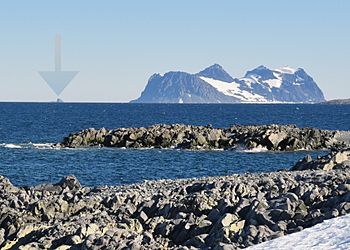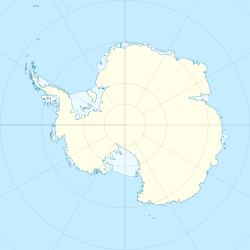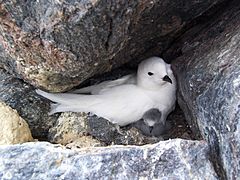Guébriant Islands facts for kids

The tiny Guébriant Islands (at arrow) seen from Rothera Point on Adelaide Island. The larger island on the right is Jenny Island
|
|
|
Location in Antarctica
|
|
| Geography | |
|---|---|
| Location | Antarctica |
| Coordinates | 67°48′S 68°25′W / 67.800°S 68.417°W |
| Administration | |
| Administered under the Antarctic Treaty System | |
| Demographics | |
| Population | Uninhabited |
The Guébriant Islands are two small islands located near the Antarctic Peninsula. You can find them in the northern part of Marguerite Bay. They are about 9 kilometers (5 nautical miles) southeast of Cape Alexandra, which is on Adelaide Island.
A French team led by Jean-Baptiste Charcot discovered these islands between 1908 and 1910. He named them "Îlots de Guébriant" to honor Jean Budes de Guébriant. He was a French Catholic missionary who worked in China.
Contents
Island Features and Location
Scientists from the Falklands Islands Dependencies Survey (FIDS) mapped the islands in 1948. Later, in 1963, the Royal Navy re-charted them. Both islands are long and narrow, stretching from northeast to southwest.
The smaller island, which is to the north, is about 500 meters long and 200 meters wide. Its highest point reaches 92 meters. The southern island is about 1,100 meters long, with a similar width. It is much flatter. A channel about 200 meters wide separates the two islands. In the summer, most of the ice melts away from the islands.
About 1 kilometer (0.6 miles) southeast of the islands is Mission Rock. This rock was also named after the missionary de Guébriant. Mission Rock is not considered part of the Guébriant Islands themselves.
On a clear day, you can see the Guébriant Islands from Rothera Research Station. This station is about 28 kilometers (17 miles) away.
Who Owns the Guébriant Islands?
Several countries believe the Guébriant Islands are part of their land. These countries are Argentina, Chile, and the United Kingdom. This is because the islands fall within areas of Antarctic territorial claims that overlap.
However, no country has a permanent base or people living on the islands. The Antarctic Treaty System helps manage these claims. It ensures that Antarctica is used only for peaceful, scientific purposes.
Plants and Animals
Scientists have looked for different kinds of life on the Guébriant Islands.
Snow Petrel Reproduction
A study from 1995 suggested that snow petrels (Pagodroma nivea) might nest on the Guébriant Islands. This idea came from a single observation made in 1962. Snow petrels are birds that live in Antarctica.
Mosses and Tiny Worms
The islands have patches of mosses. These include types like Brachythecium, Bryum, and Drepanocladus. Living within these moss communities are tiny worms called nematodes. The most common types are from the genera Plectus and Aphenchoides. In some moss patches, there can be as many as 428,000 of these worms in just a small area (2.5 cm deep) of soil!
Lichens
Two types of lichens have also been found on the islands. A lichen called Alectoria minuscula f. biformis was discovered in 1948 by B. Stonehouse and V.E. Fuchs. It was common at heights above 30 meters (100 feet). Another lichen, from the genus Lecanora, was found in 1961. It was on the sheltered side of the southern Guébriant island at an altitude of 61 meters (200 feet).



